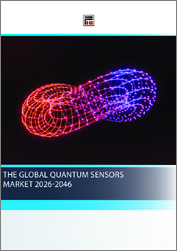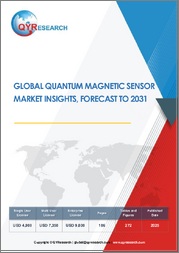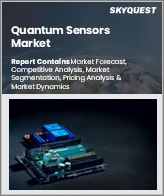
|
시장보고서
상품코드
1791928
세계의 양자 센서 시장(2026-2046년)The Global Quantum Sensors Market 2026-2046 |
||||||
세계의 양자 센서 시장은 2025년에 기세를 늘리고 있으며, 이 투자는 양자 기술이 실험실 연구 단계에서 상업적 현실로 전환되는 전환점을 상징합니다. 2025년 첫 분기에는 양자 기술 분야에 $1.25억 억 달러 이상의 자금이 유치되었으며, 이는 전년도 대비 두 배 이상 증가한 수치입니다. 이 중 양자 컴퓨팅 기업이 양자 관련 자금의 70% 이상을 차지했습니다. 양자 컴퓨팅이 헤드라인을 장식하고 있지만, 양자 센싱은 2030년대 중반까지 수십억 달러 규모의 시장으로 성장해 양자 혁명의 핵심 요소로 자리매김할 수 있습니다.
이 성장 동향은 기술의 독특한 가치 제안에서 비롯됩니다. 양자 역학 현상인 중첩과 얽힘을 활용해 의료 진단부터 지질 탐사까지 다양한 용도에서 전통적 센서의 측정 정밀도를 외에는 훨씬 초월하는 성능을 달성하는 것입니다. 최근 자금 조달 사례는 양자 센싱 용도에 대한 투자자의 지속적인 신뢰를 보여줍니다. 바리 대학교의 스핀오프 기업인 QSENSATO는 2025년 5월 LIFTT와 Quantum Italia로부터 뇌 영상 및 지질 조사 등에 적용될 미니aturized 증기 셀 기술 개발을 위해 프리시드 자금으로 유로 50만 유로를 조달했습니다. 2024-2025년 주요 투자 사례로는 Q-CTRL의 5,900만 달러 시리즈 B-2 라운드, NATO 혁신 기금이 주도한 Aquark Technologies의 유로 500만 유로 시드 자금 조달, 학계와 산업 업체 간의 다양한 파트너십이 포함됩니다.
정부의 전략적 자금 지원 프로그램은 시장 확장을 계속 촉진하고 있습니다. 중국은 양자 기술을 포함한 최첨단 분야에 1조원(1,380억 1,000만 달러)을 투입할 계획을 발표했으며, 미국 에너지부는 양자 컴퓨팅 프로젝트에 6,500만 달러를 할당했습니다. National Quantum Initiative Reauthorization Act는 5년 동안 27억 달러의 연방 정부 자금을 승인하여 양자 기술의 전략적 중요성을 명시하고 있습니다.
미래는 다양한 기술 부문과 서로 다른 성숙도 수준을 보여줍니다. 원자 시계는 통신 및 항법 시스템에서 확립된 용도를 보유한 가장 성숙한 분야입니다. 자기 센서, 특히 SQUID와 NV 기반 자기계는 의료 용도와 고급 재료 특성 분석을 촉진하며 시장 상당 부분을 차지합니다. 양자 중력계와 RF 센서 등 신기술은 특수 응용 분야에서 주목받고 있습니다.
주요 시장 도전 과제는 대량 생산을 위한 소형화 물리 패키지의 확장, 비용 절감을 통한 광범위한 채택, 고전적 대안보다 명확한 가치를 입증하는 용도별 솔루션 개발입니다. 기술 성숙도 향상, 기업 신뢰도, 지정학적 긴급성의 융합은 양자 센서가 전환점을 맞이하고 있음을 보여줍니다. 기술이 개념 검증 단계에서 상업적 전개로 전환되면서, 양자 생태계 전반에 유입되는 대규모 투자는 2030년까지 다양한 산업에서 양자 센서의 변혁적 잠재력을 실현하는 데 유리한 조건을 창출합니다.
본 보고서는 급속히 진화하는 양자 센싱 산업에 대한 포괄적인 분석을 제공하며, 이해관계자, 투자자, 기술 개발자에게 중요한 인사이트을 제공합니다. 이 포괄적인 시장 정보 보고서는 양자 센서 기술의 변혁적 잠재력을 다각도로 분석하며, 2026년부터 2046년까지의 시장 규모 전망, 경쟁 미래 분석, 전략적 권장 사항을 제공합니다.
목차
제1장 주요 요약
- 제1 및 제2 양자혁명
- 현재 양자기술 시장 상황
- 투자 상황
- 세계 각국의 정부의 대처
- 산업 동향(2024-2025년)
- 시장 성장 촉진요인
- 시장과 기술의 과제
- 기술 동향과 혁신
- 시장 예측과 미래 전망
- 새로운 용도와 이용 사례
- 양자 내비게이션
- 양자 센서 기술의 벤치마크
- 잠재적인 파괴적 기술
- 시장 맵
- 세계의 양자 센서 시장
- 양자 센서의 로드맵
제2장 소개
- 양자 센싱이란
- 양자센서의 유형
- 양자 센싱의 원리
- 양자현상
- 기술 플랫폼
- 양자 센싱의 기술과 용도
- 양자 센서를 위한 가치 제안
- SWOT 분석
제3장 양자 센싱 컴포넌트
- 개요
- 특수 컴포넌트
- 증기 셀
- VCSEL
- 양자센서용 제어전자기기
- 통합 광자와 반도체 기술
- 과제
- 로드맵
제4장 원자시계
- 기술 개요
- 시장
- 로드맵
- 고주파 발진기
- 새로운 원자 시계 기술
- 광원자 시계
- 원자 시계 소형화의 과제
- 기업
- SWOT 분석
- 시장 예측
제5장 양자 자기장 센서
- 기술 개요
- 시장 기회
- 성능
- 초전도 양자 간섭 장치(Squid)
- 광학 펌핑 자력계(OPM)
- 터널 자기 저항 센서(TMR)
- 질소 결함 센터(NV 센터)
- 시장 예측
제6장 양자 중력계
- 기술 개요
- 동작 원리
- 용도
- 로드맵
- 기업
- 시장 예측
- SWOT 분석
제7장 양자 자이로스코프
- 기술 설명
- 용도
- 로드맵
- 기업
- 시장 예측
- SWOT 분석
제8장 양자 이미지 센서
- 기술 개요
- 용도
- SWOT 분석
- 시장 예측
- 기업
제9장 양자 레이더
- 기술 개요
- 용도
제10장 양자 화학 센서
- 기술 개요
- 상업활동
제11장 양자 RF 필드 센서
- 개요
- 양자 RF 센서 유형
- 류도베리 원자 기반 전계 센서와 무선 수신기
- 질소 결함 센터 다이아몬드 전계 센서와 무선 수신기
- 시장과 용도
- 시장 예측
제12장 양자 NEMS/MEMS
- 기술 개요
- 유형
- 용도
- 과제
제13장 사례 연구
- 의료의 양자 센서 : 조기 질환 검출
- 군사 용도 : 강화 내비게이션 시스템
- 환경 모니터링
- 금융 부문 : 고주파 거래
- 양자 인터넷 : 안전한 통신 네트워크
제14장 최종 용도 산업
- 의료 및 생명과학
- 국방 밑 군사
- 환경 모니터링
- 석유 및 가스
- 운송 및 자동차
- 기타 산업
제15장 기업 프로파일(82개 기업)
제16장 부록
제17장 참고문헌
HBR 25.08.26The global quantum sensors market is experiencing increased momentum in 2025, riding a wave of record-breaking investment that signals the technology's transition from laboratory research to commercial reality. The first quarter of 2025 witnessed over $1.25 billion raised across quantum technologies-more than double the previous year-with quantum computing companies receiving more than 70% of all quantum-related funding. While quantum computing dominates headlines, quantum sensing could be worth multiple billions by the mid 2030s, establishing it as a critical component of the broader quantum revolution.
This growth trajectory reflects the technology's unique value proposition: leveraging quantum mechanical phenomena such as superposition and entanglement to achieve measurement precision far beyond classical sensor capabilities across applications ranging from medical diagnostics to geological exploration. Recent funding highlights demonstrate sustained investor confidence in quantum sensing applications. QSENSATO, a University of Bari spin-off developing chip-based quantum sensors, raised Euro-500,000 in pre-seed funding from LIFTT and Quantum Italia in May 2025 to advance miniaturized vapor cell technology for applications including brain imaging and geological surveys. Other notable 2024-2025 investments include Q-CTRL's $59 million Series B-2 round, Aquark Technologies' Euro-5 million seed funding led by the NATO Innovation Fund, and various partnerships between academic institutions and industry players.
Government initiatives continue driving market expansion through strategic funding programs. China announced plans to mobilize 1 trillion yuan ($138.01 billion) into cutting-edge fields including quantum technology, while the U.S. Department of Energy allocated $65 million specifically for quantum computing projects. The National Quantum Initiative Reauthorization Act would authorize $2.7 billion in federal funding over five years, underscoring quantum technologies' strategic importance.
The market landscape reveals distinct technology segments with varying maturity levels. Atomic clocks represent the most mature sector, with established applications in telecommunications and navigation systems. Magnetic sensors, particularly SQUIDs and NV-based magnetometers, comprise a significant percentage of the market, driven by healthcare applications and advanced materials characterization. Emerging technologies including quantum gravimeters and RF sensors are gaining traction in specialized applications.
Key market challenges include scaling miniaturized physics packages for mass production, reducing costs for broader adoption, and developing application-specific solutions that clearly demonstrate value over classical alternatives. The convergence of improved technology maturity, enterprise confidence, and geopolitical urgency positions quantum sensors at an inflection point. As the technology transitions from proof-of-concept to commercial deployment, the substantial investment flowing into the broader quantum ecosystem creates favourable conditions for quantum sensors to realize their transformative potential across multiple industries by 2030.
"The Global Quantum Sensors Market 2026-2046" report provides an exhaustive analysis of the rapidly evolving quantum sensing industry, delivering critical insights for stakeholders, investors, and technology developers. This comprehensive market intelligence report examines the transformative potential of quantum sensor technologies across multiple industry verticals, offering detailed market forecasts, competitive landscape analysis, and strategic recommendations for the next two decades.
Quantum sensors represent a paradigm shift in measurement technology, leveraging quantum mechanical principles to achieve unprecedented precision and sensitivity. This report analyzes market dynamics, technological innovations, and commercial opportunities across all major quantum sensor categories, providing stakeholders with essential intelligence for strategic decision-making in this high-growth market segment.
Report contents include:
- Market Size & Growth Projections: Detailed revenue forecasts and volume analysis from 2026-2046 across all quantum sensor categories
- Technology Roadmaps: Comprehensive development timelines for atomic clocks, magnetometers, gravimeters, gyroscopes, and emerging sensor types
- Competitive Intelligence: In-depth profiles of 85+ leading companies and emerging players in the quantum sensing ecosystem
- Application Analysis: Market opportunities across healthcare, defense, automotive, environmental monitoring, and industrial sectors
- Investment Landscape: Analysis of funding trends, government initiatives, and private sector investments driving market growth
- Market Analysis
- Global market size and growth projections through 2036
- Investment landscape and funding trends analysis
- Market segmentation by technology type and end-use industry
- Government initiatives and policy impact assessment
- Technology readiness levels across quantum sensor categories
- Technology Segments
- Atomic clocks market analysis and commercialization status
- Magnetic sensors (SQUIDs, OPMs, TMRs, NV-centers) competitive landscape
- Quantum gravimeters development roadmap and applications
- Emerging technologies: RF sensors, quantum radar, image sensors
- Component ecosystem analysis: vapor cells, VCSELs, integrated photonics
- Industry Applications
- Defense and military applications and market opportunities
- Healthcare and life sciences adoption drivers and barriers
- Transportation and automotive integration challenges
- Environmental monitoring use cases and market potential
- Oil & gas exploration applications and growth drivers
- Competitive Intelligence
- Company profiles covering startups to established players
- Technology differentiation strategies and market positioning
- Partnership dynamics and supply chain relationships
- Geographic market distribution and regional advantages
- M&A activity and consolidation trends
- Strategic Analysis
- Market entry strategies and timing recommendations
- Technology platform selection criteria
- Regulatory environment and compliance requirements
- Supply chain risk factors and mitigation strategies
- Business model evolution and pricing trends
This report features comprehensive profiles of 82 leading companies and emerging players across the quantum sensing value chain, providing detailed analysis of their technology platforms, market positioning, strategic partnerships, and commercial activities. Companies profiled include established quantum technology leaders, innovative startups, research institutions, and traditional sensor manufacturers expanding into quantum technologies.
Featured Companies include:
|
|
and more....
TABLE OF CONTENTS
1. EXECUTIVE SUMMARY
- 1.1. First and second quantum revolutions
- 1.2. Current quantum technology market landscape
- 1.2.1. Key developments
- 1.3. Investment landscape
- 1.4. Global government initiatives
- 1.5. Industry developments 2024-2025
- 1.6. Market Drivers
- 1.7. Market and technology challenges
- 1.8. Technology trends and innovations
- 1.9. Market forecast and future outlook
- 1.9.1. Short-term Outlook (2025-2027)
- 1.9.2. Medium-term Outlook (2028-2031)
- 1.9.3. Long-term Outlook (2032-2046)
- 1.10. Emerging applications and use cases
- 1.11. Quantum Navigation
- 1.12. Benchmarking of Quantum Sensor Technologies
- 1.13. Potential Disruptive Technologies
- 1.14. Market Map
- 1.15. Global market for quantum sensors
- 1.15.1. By sensor type
- 1.15.2. By volume
- 1.15.3. By sensor price
- 1.15.4. By end use industry
- 1.16. Quantum Sensors Roadmapping
- 1.16.1. Atomic clocks
- 1.16.2. Quantum magnetometers
- 1.16.3. Quantum gravimeters
- 1.16.4. Inertial quantum sensors
- 1.16.5. Quantum RF sensors
- 1.16.6. Single photon detectors
2. INTRODUCTION
- 2.1. What is quantum sensing?
- 2.2. Types of quantum sensors
- 2.2.1. Comparison between classical and quantum sensors
- 2.3. Quantum Sensing Principles
- 2.4. Quantum Phenomena
- 2.5. Technology Platforms
- 2.6. Quantum Sensing Technologies and Applications
- 2.7. Value proposition for quantum sensors
- 2.8. SWOT Analysis
3. QUANTUM SENSING COMPONENTS
- 3.1. Overview
- 3.2. Specialized components
- 3.3. Vapor cells
- 3.3.1. Overview
- 3.3.2. Manufacturing
- 3.3.3. Alkali azides
- 3.3.4. Companies
- 3.4. VCSELs
- 3.4.1. Overview
- 3.4.2. Quantum sensor miniaturization
- 3.4.3. Companies
- 3.5. Control electronics for quantum sensors
- 3.6. Integrated photonic and semiconductor technologies
- 3.7. Challenges
- 3.8. Roadmap
4. ATOMIC CLOCKS
- 4.1. Technology Overview
- 4.1.1. Hyperfine energy levels
- 4.1.2. Self-calibration
- 4.2. Markets
- 4.3. Roadmap
- 4.4. High frequency oscillators
- 4.4.1. Emerging oscillators
- 4.5. New atomic clock technologies
- 4.6. Optical atomic clocks
- 4.6.1. Chip-scale optical clocks
- 4.6.2. Rack-sized atomic clocks
- 4.7. Challenge in atomic clock miniaturization
- 4.8. Companies
- 4.9. SWOT analysis
- 4.10. Market forecasts
- 4.10.1. Total market
- 4.10.2. Bench/rack-scale atomic clocks
- 4.10.3. Chip-scale atomic clocks
5. QUANTUM MAGNETIC FIELD SENSORS
- 5.1. Technology overview
- 5.1.1. Measuring magnetic fields
- 5.1.2. Sensitivity
- 5.1.3. Motivation for use
- 5.2. Market opportunity
- 5.3. Performance
- 5.4. Superconducting Quantum Interference Devices (Squids)
- 5.4.1. Introduction
- 5.4.2. Operating principle
- 5.4.3. Applications
- 5.4.4. Companies
- 5.4.5. SWOT analysis
- 5.5. Optically Pumped Magnetometers (OPMs)
- 5.5.1. Introduction
- 5.5.2. Operating principle
- 5.5.3. Applications
- 5.5.3.1. Miniaturization
- 5.5.3.2. Navigation
- 5.5.4. MEMS manufacturing
- 5.5.5. Companies
- 5.5.6. SWOT analysis
- 5.6. Tunneling Magneto Resistance Sensors (TMRs)
- 5.6.1. Introduction
- 5.6.2. Operating principle
- 5.6.3. Applications
- 5.6.4. Companies
- 5.6.5. SWOT analysis
- 5.7. Nitrogen Vacancy Centers (N-V Centers)
- 5.7.1. Introduction
- 5.7.2. Operating principle
- 5.7.3. Applications
- 5.7.4. Synthetic diamonds
- 5.7.5. Companies
- 5.7.6. SWOT analysis
- 5.8. Market forecasts
6. QUANTUM GRAVIMETERS
- 6.1. Technology overview
- 6.2. Operating principle
- 6.3. Applications
- 6.3.1. Commercial deployment
- 6.3.2. Comparison with other technologies
- 6.4. Roadmap
- 6.5. Companies
- 6.6. Market forecasts
- 6.7. SWOT analysis
7. QUANTUM GYROSCOPES
- 7.1. Technology description
- 7.1.1. Inertial Measurement Units (IMUs)
- 7.1.1.1. Atomic quantum gyroscopes
- 7.1.1.2. Quantum accelerometers
- 7.1.1.2.1. Operating Principles
- 7.1.1.2.2. Grating magneto-optical traps (MOTs)
- 7.1.1.2.3. Applications
- 7.1.1.2.4. Companies
- 7.1.1. Inertial Measurement Units (IMUs)
- 7.2. Applications
- 7.3. Roadmap
- 7.4. Companies
- 7.5. Market forecasts
- 7.6. SWOT analysis
8. QUANTUM IMAGE SENSORS
- 8.1. Technology overview
- 8.1.1. Single photon detectors
- 8.1.2. Semiconductor single photon detectors
- 8.1.3. Superconducting single photon detectors
- 8.2. Applications
- 8.2.1. Single Photon Avalanche Diodes with Time-Correlated Single Photon Counting (TCSPC
- 8.2.2. Bioimaging
- 8.3. SWOT analysis
- 8.4. Market forecast
- 8.5. Companies
9. QUANTUM RADAR
- 9.1. Technology overview
- 9.1.1. Quantum entanglement
- 9.1.2. Ghost imaging
- 9.1.3. Quantum holography
- 9.2. Applications
- 9.2.1. Cancer detection
- 9.2.2. Glucose Monitoring
10. QUANTUM CHEMICAL SENSORS
- 10.1. Technology overview
- 10.2. Commercial activities
11. QUANTUM RADIO FREQUENCY (RF) FIELD SENSORS
- 11.1. Overview
- 11.2. Types of Quantum RF Sensors
- 11.3. Rydberg Atom Based Electric Field Sensors and Radio Receivers
- 11.3.1. Principles
- 11.3.2. Commercialization
- 11.4. Nitrogen-Vacancy Centre Diamond Electric Field Sensors and Radio Receivers
- 11.4.1. Principles
- 11.4.2. Applications
- 11.5. Market and applications
- 11.6. Market forecast
12. QUANTUM NEMS AND MEMS
- 12.1. Technology overview
- 12.2. Types
- 12.3. Applications
- 12.4. Challenges
13. CASE STUDIES
- 13.1. Quantum Sensors in Healthcare: Early Disease Detection
- 13.2. Military Applications: Enhanced Navigation Systems
- 13.3. Environmental Monitoring
- 13.4. Financial Sector: High-Frequency Trading
- 13.5. Quantum Internet: Secure Communication Networks
14. END-USE INDUSTRIES
- 14.1. Healthcare and Life Sciences
- 14.1.1. Medical Imaging
- 14.1.2. Drug Discovery
- 14.1.3. Biosensing
- 14.2. Defence and Military
- 14.2.1. Navigation Systems
- 14.2.2. Underwater Detection
- 14.2.3. Communication Systems
- 14.3. Environmental Monitoring
- 14.3.1. Climate Change Research
- 14.3.2. Geological Surveys
- 14.3.3. Natural Disaster Prediction
- 14.3.4. Other Applications
- 14.4. Oil and Gas
- 14.4.1. Exploration and Surveying
- 14.4.2. Pipeline Monitoring
- 14.4.3. Other Applications
- 14.5. Transportation and Automotive
- 14.5.1. Autonomous Vehicles
- 14.5.2. Aerospace Navigation
- 14.5.3. Other Applications
- 14.6. Other Industries
- 14.6.1. Finance and Banking
- 14.6.2. Agriculture
- 14.6.3. Construction
- 14.6.4. Mining
15. COMPANY PROFILES (82 company profiles)
16. APPENDICES
- 16.1. Research Methodology
- 16.2. Glossary of Terms
- 16.3. List of Abbreviations



















